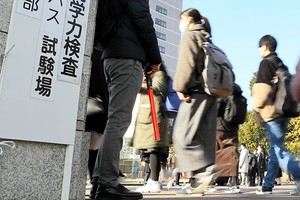THE ASSOCIATED PRESS
March 30, 2022 at 11:40 JST
 A woman walks along a sidewalk past a TV displaying a news program on North Korea’s missile launch Thursday, March 24, 2022, in Tokyo. (AP Photo)
A woman walks along a sidewalk past a TV displaying a news program on North Korea’s missile launch Thursday, March 24, 2022, in Tokyo. (AP Photo)
SEOUL--South Korea on Tuesday dismissed North Korea’s claim to have launched a newly developed intercontinental ballistic missile last week, accusing the country of firing a less-powerful existing weapon and fabricating data following an earlier failed launch.
North Korea said it launched a Hwasong-17 missile, its longest-range developmental ICBM, last Thursday in its biggest weapons test in years. Its state media called the launch “a historical event” and released a stylized Hollywood-style video showing leader Kim Jong Un, in sunglasses and leather jacket, supervising the launch.
But South Korea’s Defense Ministry said Tuesday it has determined that what North Korea fired wasn’t a Hwasong-17 but a Hwasong-15, another ICBM that it successfully tested in 2017.
Both missiles are potentially capable of reaching the U.S. mainland. But analysts say the Hwasong-17 has a longer potential range and its huge size suggests that it’s designed to carry multiple nuclear warheads to defeat missile defense systems. Believed to be about 25 meters long, the Hwasong-17 is, by some estimates, the world’s biggest road-mobile ballistic missile system.
The Defense Ministry said it told a parliamentary committee that details of Thursday’s launch--such as the missile’s speed, combustion and stage separation--were similar to those of the Hwasong-15, not the Hwasong-17. The ministry report to the committee also suggested that the North Korean video wasn’t shot on the actual launch date, citing an analysis of Kim’s shadow and weather conditions seen in the video.
The report said the United States agreed with the South Korean assessment and is separately analyzing the launch.
Japanese Chief Cabinet Secretary Hirokazu Matsuno said Monday that Tokyo’s assessment that North Korea launched a new type of ICBM remained unchanged. Matsuno said the missile poses a greater threat to Japan and the international community than other weapons North Korea has fired.
Thursday’s launch was North Korea’s most serious provocation since its Hwasong-15 launch in November 2017. It was also the latest in a slew of missile tests it has conducted this year in an apparent bid to modernize its arsenal and ramp up pressure on the Biden administration amid stalled nuclear talks between the two countries.
According to the assessments of both North Korea and its neighbors, the missile fired last Thursday flew higher and longer than any other North Korean weapon tested so far. Some experts say North Korea may have mounted a much lighter payload on the Hwasong-15 to help it fly further than its previous launch in 2017.
The South Korean Defense Ministry said the alleged North Korean deception was likely related to a previous failed attempt to launch the Hwasong-17 earlier this month.
According to South Korean accounts, the missile fired from North Korea’s capital region on March 16 exploded soon after liftoff and many residents of Pyongyang witnessed the mid-air blast. The ministry report said North Korea is believed to have then decided to launch a reliable ICBM which it could successfully fly to prevent possible public anxiety and bolster unity at home.
It said it is also likely that North Korea attempted to deceive its rivals into believing it has advanced ICBM technology to cement its image as a military power and increase its leverage in future negotiations.
Ha Tae-keung, a member of parliament’s defense committee, told reporters that the ministry said the explosion occurred at an altitude of only several kilometers. He cited the ministry as saying the blast “sent debris like rain over Pyongyang” though civilian casualties haven’t been independently confirmed.
Colin Zwirko, a senior analyst at the North Korea-focused website NK Pro, earlier said commercial satellite images indicated that North Korean state TV video of the launch was likely shot on a different date. He said this raises the possibility that North Korea botched a Hwasong-17 test on March 16.
Prior to the failed March 16 launch, the South Korean and U.S. militaries said North Korea tested a Hwasong-17 system twice earlier this year in launches that flew medium distances. Some observers said North Korea was likely testing the first stage of the Hwasong-17, but North Korea said it tested cameras and other systems for a spy satellite without disclosing what missile or rocket it fired. The North didn't comment on the failed launch.
South Korean officials said this week that North Korea may raise tensions further in coming weeks by conducting another ICBM test, a prohibited launch of a rocket to place its first functioning spy satellite into orbit, or even a nuclear test.
North Korean state media didn’t immediately respond to the South Korean Defense Ministry report.




















A peek through the music industry’s curtain at the producers who harnessed social media to help their idols go global.
A series based on diplomatic documents declassified by Japan’s Foreign Ministry
Here is a collection of first-hand accounts by “hibakusha” atomic bomb survivors.
Cooking experts, chefs and others involved in the field of food introduce their special recipes intertwined with their paths in life.
A series about Japanese-Americans and their memories of World War II